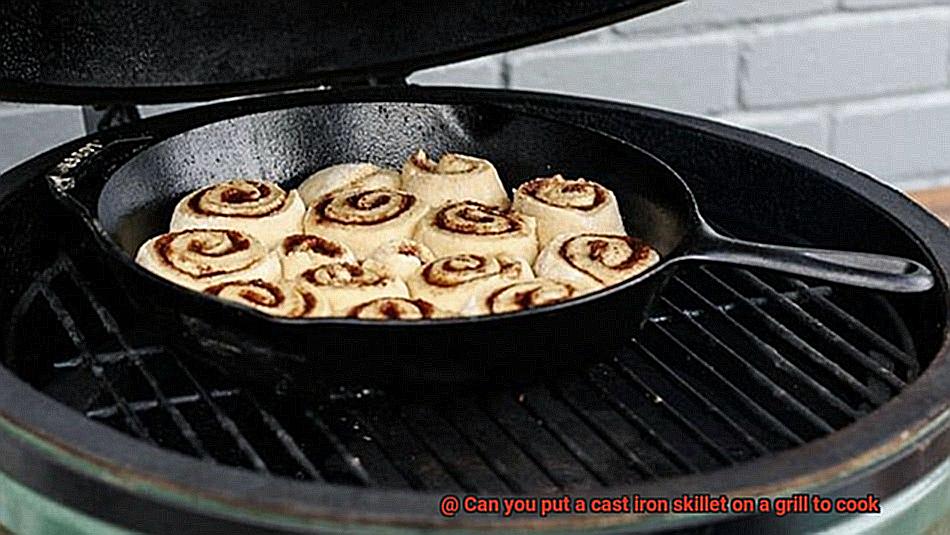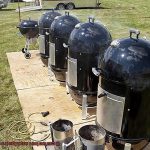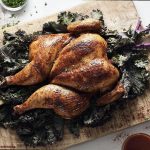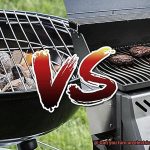Are you a fan of the rich, unmistakable flavor that only a cast iron skillet can impart to your favorite dishes? Have you ever wondered if you could combine that same deliciousness with the smoky goodness of outdoor grilling? If so, it’s time to embark on a culinary adventure that will elevate your cuisine to new heights.
Grilling is a beloved pastime enjoyed by many around the globe, but sometimes we crave something different. Placing a cast iron skillet on the grill creates a unique cooking experience that blends the savory char of the grill with the superior heat retention capabilities of cast iron. But can you really use a cast iron skillet on the grill for cooking?
In this blog post, we’ll delve into all aspects of using a cast iron skillet on the grill, including its benefits, necessary precautions, and potential drawbacks. We’ll also explore which foods work best with this technique and provide some expert tips for achieving culinary perfection every time.
Whether you’re an avid griller or devoted cast iron enthusiast, get ready to discover exciting new possibilities for your trusty skillet on the grill. So keep reading to learn more.
Contents
What is a Cast Iron Skillet?
Cast iron skillets are a timeless kitchen essential known for their durability and versatility. These cooking tools are made from an alloy of iron, carbon, and silicon that allows them to distribute heat evenly and retain it for extended periods. The result is perfectly cooked dishes that are seared, fried, baked, or roasted to perfection.
One of the defining features of cast iron skillets is their seasoning process. Before use, the skillet is coated in oil and baked at high temperatures to create a non-stick surface that adds flavor to your dishes. This seasoning process is what makes cast iron skillets so unique and beloved by chefs and home cooks alike.
Cast iron skillets come in various shapes and sizes, from small to large, round, square, or rectangular. They are perfect for a variety of cooking tasks such as making cornbread, pancakes, or searing meats and vegetables. Additionally, they are versatile enough to be used both indoors and outdoors on stovetops, ovens, campfires, and grills.
When it comes to using cast iron skillets on a grill, there are some important precautions to keep in mind. First and foremost, choose the right skillet for the job—long handles and ridges on the bottom can make grilling easier and create those desirable grill marks. Before placing the skillet on the grill, be sure to preheat it just like you would if you were cooking on the stove. This will ensure even heating and prevent food from sticking.
As cast iron retains heat well, it’s important to monitor the temperature of your grill and adjust as needed throughout the cooking process. Once you’re done grilling, let the skillet cool down before handling it to avoid any burns or damage.
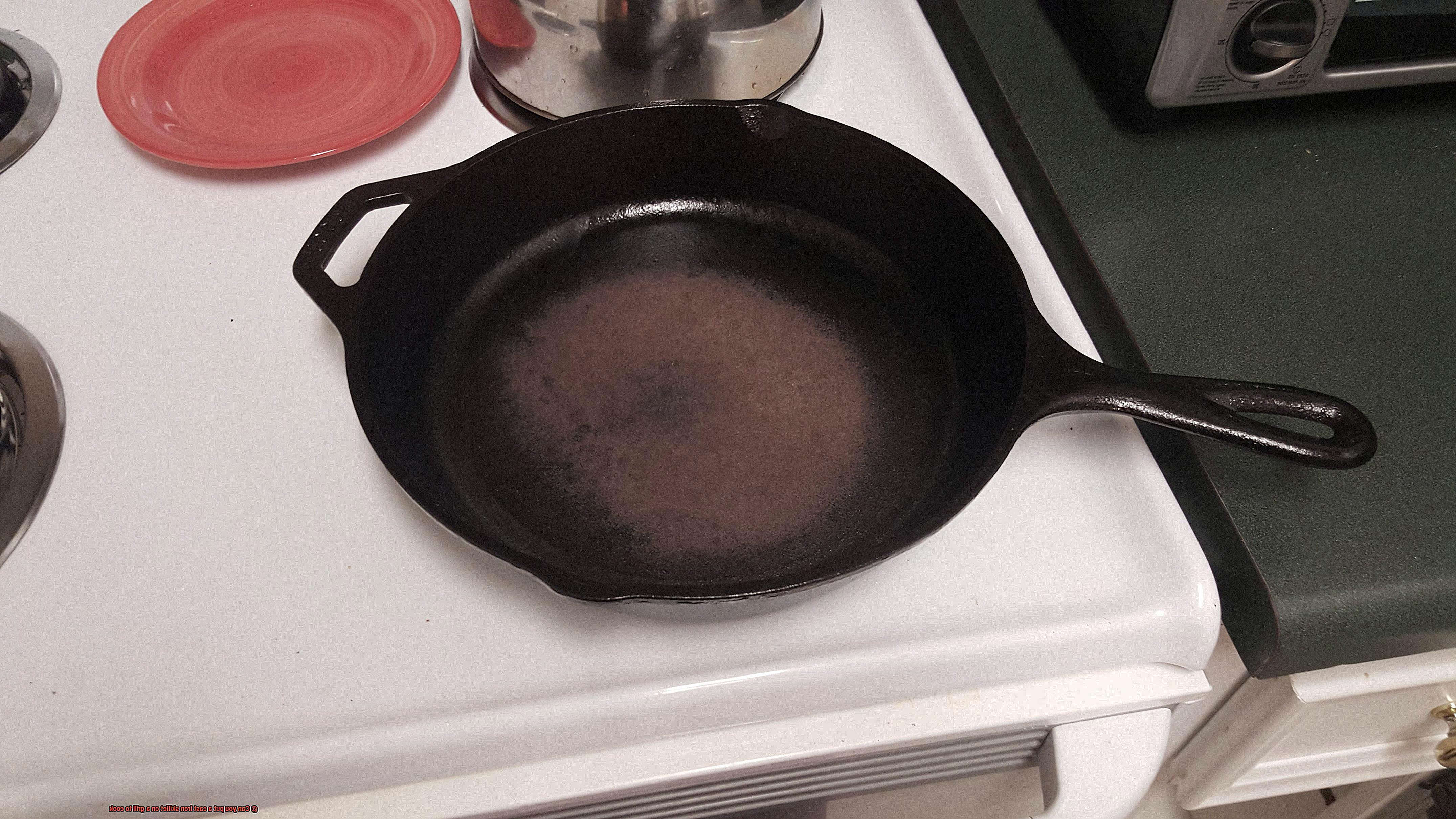
Are All Cast Iron Skillets Suitable for Grilling?
Firstly, size is essential. A larger skillet may be too heavy to handle safely or not fit on your grill. So, choose a size that suits your grill and cooking needs.
Secondly, consider the type of cast iron skillet you have. Some skillets come with ridges on the bottom, specifically designed for grilling and creating those perfect grill marks on your food. These ridges are ideal for cooking juicy burgers, steaks, and other meats.
However, if your skillet lacks ridges, don’t worry. You can still use it for grilling, but you might not achieve the same sear or grill marks on your food. Just ensure that your skillet is well-seasoned before using it on the grill to prevent any sticking and make cleanup a breeze.
In summary, not all cast iron skillets are suitable for grilling. But with the right size and type of skillet, you can achieve excellent results on your grill. So go ahead and fire up that grill with confidence, knowing that you have chosen the perfect cast iron skillet for the job.
Preheating Your Cast Iron Skillet
Before you get started, it’s important to understand the crucial step of preheating your skillet.
Why is preheating so important? For starters, it ensures even cooking. When your skillet is heated up, it distributes heat evenly across the surface, preventing any hot spots that could cause unevenly cooked food. This means your steak will be perfectly seared and juicy, and your veggies will be tender and flavorful.
Preheating also helps prevent sticking, creating a non-stick surface that makes cooking and cleanup much easier. So how do you preheat your cast iron skillet? Let’s explore the options.
You can preheat your skillet on the grill by simply placing it on the grates and letting it heat up for at least 10 minutes before adding food. Alternatively, you can preheat it in the oven at 450°F for about 20 minutes before transferring it to the grill.
However, it’s important to take safety into consideration when preheating your skillet. Cast iron skillets become very hot, so use oven mitts or heat-resistant gloves when handling them. And avoid using high heat settings on your grill as this can cause your skillet to overheat and potentially warp.
Keep in mind that cast iron skillets retain heat well, which means they will continue to cook your food even after you remove them from the grill. Adjust your cooking times accordingly to avoid overcooking.
Adding Food to the Grill
Before you get started, there are a few things to keep in mind. First and foremost, make sure your grill is hot enough. Cast iron skillets require high heat to cook properly, so preheat your grill before adding the skillet. And don’t forget to oil the skillet beforehand to prevent any sticking.
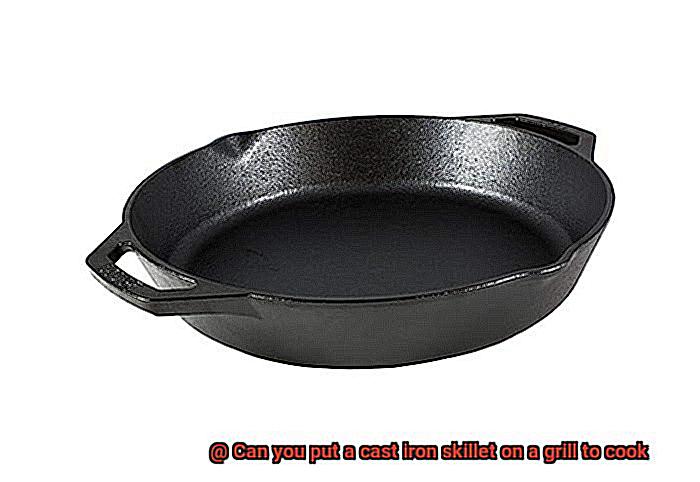
Once your skillet is heated up and ready to go, it’s time to start adding your food. But be careful not to overcrowd the skillet – this can prevent proper air circulation and lead to uneven cooking. Try experimenting with different foods, from vegetables to meats, for a wide range of tasty results.
Speaking of tasty results, using a cast iron skillet on the grill can give your food a unique flavor profile and those coveted grill marks. Just make sure to adjust cooking times accordingly and keep a watchful eye on your food.
Monitoring Temperature on the Grill
Then, you’ll need to know how to monitor the temperature on your grill. This may sound daunting, but fear not. With a few reliable tools and techniques, you can master the art of monitoring temperature on the grill when cooking with a cast iron skillet.
First and foremost, it’s important to understand that several factors can affect the temperature of your grill. Factors such as weather conditions, fuel types, and skillet size can all play a role in determining how well your food cooks. Therefore, it’s crucial to have reliable tools to help you monitor the heat.
One option is a digital thermometer. This tool offers an accurate reading of the temperature inside your skillet, allowing you to cook your food to perfection without any guesswork. Another option is an infrared thermometer which helps you measure the surface temperature of your skillet. This will enable you to determine if your food is cooking evenly and avoid hot spots.
If you don’t have a thermometer on hand, don’t worry. You can also use a grill lid thermometer to get a general idea of the temperature inside your grill. However, keep in mind that this may not always be an accurate representation of the temperature inside your skillet.
When cooking with a cast iron skillet on the grill, trial and error is key. Start by preheating your skillet on the grill and testing different heat levels until you find the ideal temperature for your specific recipe. Be sure to check the temperature regularly throughout the cooking process and make necessary adjustments.
To sum up, monitoring temperature on the grill when cooking with a cast iron skillet requires patience and practice. Use reliable tools like digital or infrared thermometers and experiment with different heat levels until you find the perfect balance for your recipe. Keep in mind that other variables like wind or ambient temperature changes may also impact your cooking experience.
In short, here are some key takeaways to master monitoring temperature on the grill:
- Understand that various factors can affect the temperature of your grill
- Use reliable tools like digital or infrared thermometers to help you monitor the heat
- Experiment with different heat levels until you find the ideal temperature for your specific recipe
- Regularly check the temperature throughout the cooking process and make necessary adjustments
Keeping an Eye on Food Safety
While it can be a great way to cook up delicious meals, it is important to keep an eye on food safety. Here are some tips to help you ensure that your food is cooked safely and without any risk of contamination:
Clean and season your cast iron skillet properly: Before using your cast iron skillet on the grill, make sure that it is properly cleaned and seasoned. This will help prevent any harmful bacteria or contaminants from being transferred to your food. A well-seasoned skillet also ensures that your food won’t stick, making flipping and serving much easier.
Monitor the temperature closely: When cooking with a cast iron skillet on the grill, it is essential to monitor the temperature carefully to ensure that your food reaches the proper internal temperature. Using reliable tools like digital or infrared thermometers can help you keep an eye on the temperature and ensure that your food is cooked through.
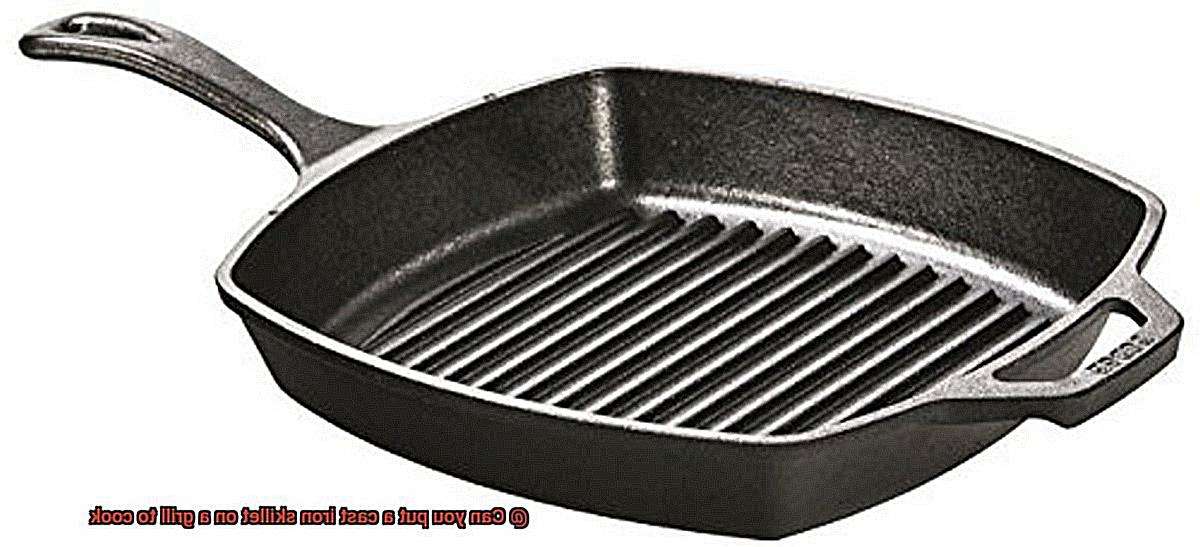
Use proper handling techniques: Always use oven mitts or other protective gear when handling your skillet on the grill to avoid burns. The skillet can get extremely hot, so it’s essential to use proper handling techniques when moving it around. Make sure that any utensils or tools you use are clean and free of contaminants.
Keep your grill clean: A dirty grill can cause cross-contamination, making it important to keep it clean and free of debris or leftover food particles. Before cooking, make sure to scrape off any leftover residue and wipe down the grates with a damp cloth.
Cooling Down Your Cast Iron Skillet
Grilling with a cast iron skillet is a time-honored tradition, but it comes with its own set of challenges. One of the most important things to keep in mind is how to safely cool down your skillet after use. With these tips and tricks, you’ll be able to cool down your skillet like a pro.
First and foremost, never use cold water to cool down a hot cast iron skillet. This can cause irreparable damage, such as warping or cracking. Instead, let the skillet cool down on its own for at least 10-15 minutes before attempting to handle it.
Once your skillet has cooled down, it’s time to give it a proper cleaning. Use a stiff-bristled brush or scraper to remove any remaining food debris. Avoid using soap or harsh chemicals as this can strip away the seasoning on the skillet. Instead, opt for hot water and a sponge or cloth to clean the skillet thoroughly.
After cleaning, don’t forget to dry the skillet thoroughly as well. You can either use a towel or place the skillet on low heat on the grill for a few minutes until it’s completely dry.
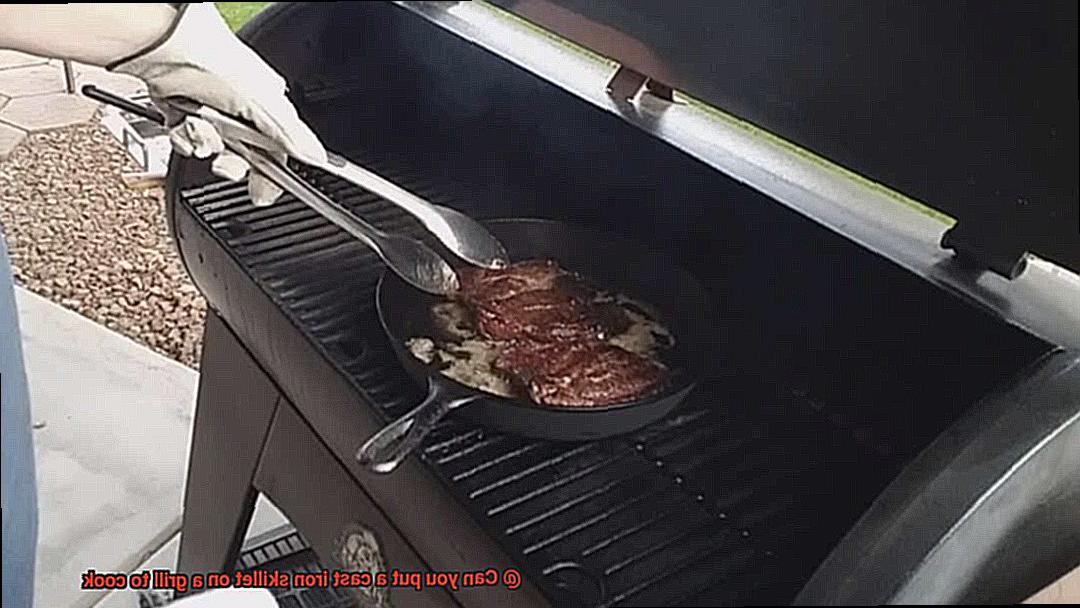
To ensure your skillet stays in tip-top shape, it’s important to apply a thin layer of oil after drying. This will help protect the seasoning and prevent rust from forming.
-jCIqvq6Boo” >
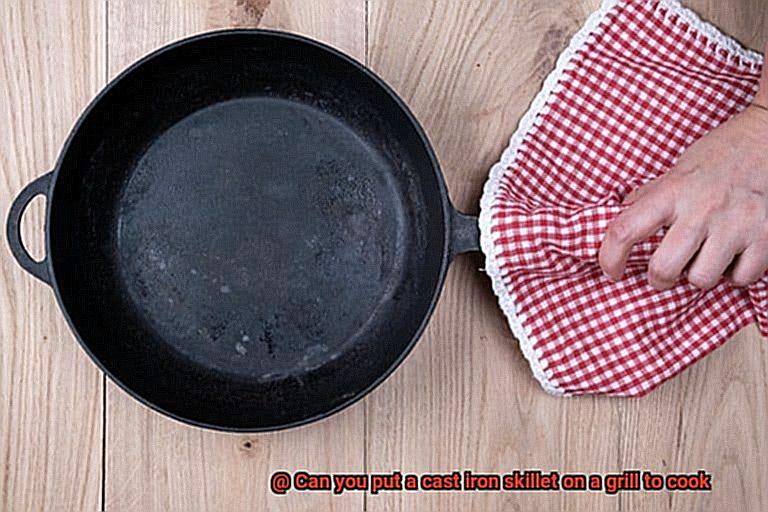
Also Read: Can you cook in a pan on a blackstone griddle?
Conclusion
In conclusion, using a cast iron skillet on the grill is a game-changer for outdoor cooking enthusiasts. These versatile and durable kitchen essentials are perfect for searing, frying, baking, or roasting your favorite dishes. Their ability to distribute heat evenly and retain it for extended periods makes them ideal for grilling.
However, before you start cooking with your cast iron skillet on the grill, there are some precautions to keep in mind. Choosing the right size and type of skillet is crucial for achieving excellent results. Preheating the skillet and monitoring temperature on the grill are also essential steps to ensure even cooking and prevent food from sticking.
To ensure food safety, always clean and season your skillet properly before use. And if you want to take your grilling game up a notch, invest in reliable tools like digital or infrared thermometers to monitor temperature closely.
Once you’ve finished cooking with your cast iron skillet on the grill, don’t forget about proper cooling down techniques. Never use cold water to cool down a hot skillet as this can cause irreparable damage. Instead, let it cool down naturally before giving it a proper cleaning and applying a thin layer of oil to protect its seasoning.
With these tips and tricks in mind, you’ll be able to master the art of using a cast iron skillet on the grill and create mouth-watering meals with that unique smoky flavor we all love.

